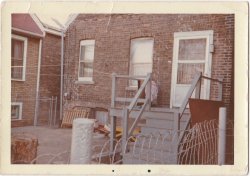
MAY CONTAIN NUTS

Search Shorpy
SHORPY ART

Framed or unframed, desk size to sofa size, printed by us in Arizona and Alabama since 2007. Explore now.
Join and Share
Ad-Free Shorpy
Shorpy is funded by you. Patreon contributors get an ad-free experience.
Learn more.

Recent comments
- Famous Hollywood faces
- Not just S&P
- re: Those things in the jar
- Up In Smoke
- Medical Smoking
- Quick fix
- A Quink Comment
- If You’re Like Me, Never
- Delivering the News
- U.S.A.
- S&P
- 1940 Zenith radio model 6G601
- Quality goes in before the name goes on!
- Snazzy skirt
- Carbon Arc Lamps
- Illuminate us
- I remember it well
- I can't prove it
- Complicated then, forgotten now
- Bryan-Stevenson
- Skinny is as skinny does
- How do you rest in peace
- Riding the footboards
- Alas, hidden from view
- Baldwin Diesels
- Exclusive pump
- Bananas, Oysters and Smokey Joe
- Details, Details
- What's that building to the left of the tower?
- Coal Barges
Member Photos
The Shorpy
Print Emporium
Print Emporium
Search Shorpy
Search results -- 30 results per page
- Ice House: 1943
- ... ice storehouse of the Indiana Harbor Belt Railroad near Chicago. It has a storage capacity of almost 15,000 tons." Medium format ... ice for cooling. That particular railroad connected to the Chicago stockyards and so probably shipped a lot of refrigerated loads.
Ice ... Posted by Dave - 07/27/2023 - 11:35am -
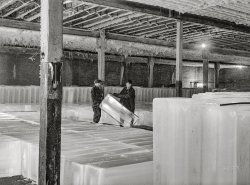
- Woodward Avenue: 1917
- ... is the 1896 Majestic Building, designed by the famous Chicago architect Daniel Burnham. Among other things, Burnham also designed the ... Posted by Dave - 07/24/2012 - 9:50pm -
![Woodward Avenue: 1917 Detroit, Michigan, circa 1917. "Looking up Woodward Avenue." Dry plate glass negative, Detroit Publishing Company. View full size.
"Mellow as Moonlight"If I was a drinkin' man, I would be sippin' some a that Cascade whiskey.
Motor city, for sure!Not one single horse in view.
Temporal AcheMan, this is one of those Shorpy photos that really make me wish I had a time machine.
Not much leftAbout the only thing still remaining is the Soldiers' and Sailors' Monument, and even it has been moved about 300 feet from where it stood for 130 years.
An amazing photo.
Casting against TypeI see the film "Somewhere in Georgia" is playing, where Ty Cobb stars surprisingly as a small-town Georgia baseball player who signs with the Detroit Tigers.
Health InsuranceAlmost 100 years later, the country is in a major pique over health Insurance and the Detroit Creamery had the answer all along. This maybe the best urban photograph yet, it certainly is the busiest.
Notice the #2 streetcar?It's got one of those fancy-schmancy 'people scoopers' on it, like this:
https://www.shorpy.com/node/4468
HodgepodgeOne of the best urban pictures yet! Too much to take in at one sitting; The Opera House, that wonderful memorial, the traffic, those streetcars. I wonder what the tent was for in front of that fountain, just across from the Opera House.
FascinatingThere's so much to look at in this photo. I especially enjoy seeing people going about their daily lives, not posing for a camera.
The movie theater sign says "All Next Week, Somewhere in Georgia". According to IMDB.com "Somewhere in Georgia", starring Ty Cobb, was filmed in the winter of 1916 and released in June 1917. Is the 1915 date on the photo in error?
[Do we know what "circa" means? - Dave]
An Edison ElectricI notice that the Edison Electric is being driven by a woman. My grandmother (who lived in Detroit) said that the only car she ever drove was an Edison Electric. She was afraid of driving a gasoline-powered car.
[Women liked electrics because there were no gears to shift, and no clutch -- shifting and clutching on cars of that era required quite a bit of muscle. - Dave]
Cloudy crystal ballCover story in Time Magazine, October 5, 2009: "The Tragedy of Detroit: How a great city fell, and it it can rise again."
Speaking of moonlightFarewell, good moonlight towers. Twenty years gone by the time of this photo.
Is it a coincidence that Shorpy has hit upon another star of the silent screen? The theater beneath the Blackstone Cigar sign (far right)features Gladys Brockwell, who, like Kay Laurell (1890-1927), died in her thirties. Horrific 1929 car crash in California.
Merrill FountainThe Merrill Fountain in front of the Opera House still exists, too. Granted, it was moved about seven miles up the road to Palmer Park.
Before it was called Wootwart (Woodward)The definition of the "good old days" ...
Traffic LightsGreat image. Did traffic lights look different then, or did they not have them in Detroit?
[In 1917, traffic signals came on two legs. - Dave]
Re: An Edison ElectricLooks more like a Detroit Electric car than the very rare Edison.
The main reason the ladies like the electric car was no crank starting. Charles Kettering changed that a few years later with the electric starter motor if IC engines.
Notice the complete absenceof horse poop. And horses.
Stop sign doesn't apply...Surprised to see that pedestrains do not follow traffic signs as they crossed the streets. It seems that those signs were for trolleys and cars only. It anwered my question why my g-g-great uncle got killed by a trolley.
ProsperityWow! You can almost hear the hustle and bustle of prosperity in this amazing photograph -- the essence of early 20th century proud American urbanity. Go to Google Earth or some other mapping web site and visit the corner of Woodward and Fort today -- a dreary, faceless, lifeless desert of glassy highrises without a pedestrian in sight.
HeartbreakingWhen I go through Detroit now it is a vast third world, broken down, trashed city, with gangs and thugs peering from behind collapsed buildings. How in the name of all that is worthy could this magnificent American city come to what it is today? Almost makes me want to watch Glenn Beck.
Oh what a feelingI had to smirk a bit when I opened of the intersection on Google streets and the first thing I saw was a shiny Toyota.
FABULOUSThis image is go busy and wonderful. There is so much to notice. I wonder what the conversations were and so much more.
There is a tent in the middle of the square to the left of the statue. Why? What is the statue of?
All in WhiteI love the woman all in white crossing the street with her plaid skirted friend (near the front of the photo, just before the frontmost car). She looks so different than everyone else.
I bet the two women just walking into the frame below them are talking about her. She's showing ankle AND calf! I'm sure she'll be a flapper in a few years!
The girl in whiteI think that the girl in white is in fact a girl - probably a young teen accompanying her mother (the lady in the plaid skirt). Therefore she would be perfectly well dressed for her age. However that also means that she would be in the right demographic to become a flapper once the twenties (which would coincide with her twenties) rolled around.
Great picture - Lord I could look at it for hours!
That banner over the street"ENLIST NOW! YOUR COUNTRY NEEDS YOU"
And to your left...Seems even Detroit had its requisite "Seeing..." touring bus company. I count three "charabancs" in this photo, one across the street from Bond's with "WELLS" emblazoned on the back, and two in the centre-left crammed with mostly female tourists. Wonder what they were off to see next?
I'm loving the little insignificant human moments the photographer caught and immortalized: the man at the lower left trying to make something out on a bulletin board; the hefty many putting his arm around his companion's waist next to the memorial; three ladies converging outside the theater. Fantastic.
The building on the far leftis the 1896 Majestic Building, designed by the famous Chicago architect Daniel Burnham. Among other things, Burnham also designed the Flatiron Building in NYC, and oversaw the construction of the 1893 World's Columbian Exposition. The Majestic was Detroit's tallest building until 1909, when the Ford Building (also a Burnham creation) was completed. The Ford still stands today, as well as Burnham's other Detroit creations, the David Whitney Building and the Dime Building. Sadly the Majestic was torn down in 1962 to make way for the exponentially less-interesting 1001 Woodward Building.
“Make no little plans; they have no magic to stir men’s blood and probably themselves will not be realized. Make big plans; aim high in hope and work, remembering that a noble, logical diagram once recorded will not die, but long after we are gone be a living thing, asserting itself with ever-growing insistence. Remember that our sons and our grandsons are going to do things that would stagger us. Let your watchword be order and your beacon beauty.”
-Daniel H. Burnham
Sight Seeing in Detroit ca. 1917The Dietsche Sight Seeing Company was one of several companies that offered tours of Detroit back in this time period. Below is a photo of their advertisement offering their services to local companies who might want to entertain their out-of-town customers with a "Sight Seeing Trip around the city, Belle Isle, or Water Works Park."
Given the description of the street banner, this photo was probably taken sometime around June 5, 1917, which was the date on which all men between the ages of 21 and 31 were required to register for the draft.
Soldiers and Sailors MonumentStill nearby, but not as nicely maintained.
Very Nicely MaintainedThe Soldiers & Sailors monument is actually very well maintained. Notice how it's not all blackened with soot as in the old photo. When you view it up close you can also see where some very nice restoration has recently been done. Not everything in Detroit is a rotting hulk.
Still busyNot like this, but the ice skating rink at Campus Martius is already set up and would be approximately directly in front of the Detroit Opera House. Downtown Detroit is not the home of thugs or crime at all, really, but is sadly quiet when the businesses are closed. Many of the buildings are still here, and magnificent. Come visit before they tear them all down.
I'll be ordering a large print of this image! Thank you Shorpy.
Re. "Mellow as Moonlight"I saw this photo a few days ago, and, like GeezerNYC, I was quite struck by the Cascade Whiskey billboard. Now, I know that Geo. Dickel is still in business, and I was familiar with Dickel's Tennessee Sipppin' Whiskey and Old No. 8, but I had never heard of Cascade. It must have gone the way of the buggy whip and Lydia Pinkham, I thought.
But then today I stopped at the liquor store after work to pick up a bottle of wine, and GUESS WHAT THEY HAD?!?! shhhh...too loud. So, then
and I bought some. And do you guys know what? It's pretty goood. I';m drikning it right now. And I just wanna
True story I swear.
Hey! do you know what? I bought some oft hat Cacsade whiskey? Or is it whishky? Aanyway, I just wanna
You know what/ You guys are greatf. I just wanna
Hudson's Grows, and...Hudson's grew with Detroit, and perhaps inevitably, declined with Detroit.
Cascade HollowThe current Cascade Hollow Whiskey was created to deal with a shortage of the Dickel No. 8 and then just hung around. They didn't have enough whiskey of a certain age so they made a new brand and put their younger stuff in it so that the quality of the No. 8 wouldn't suffer. The Cascade Hollow has been discontinued, but it's still on the shelves in many places.
The name Cascade was replaced by the Dickel name after Prohibition and a number.
In order of price (& quality) the current Dickel offerings are:
(Cascade Hollow)
Dickel No. 8
Dickel No. 12
Dickel Barrel Select (which is one of the best whiskeys I've ever had. And I've had a lot.)
Anyway, Dickel is currently owned by the evil international spirits conglomorate Diageo, which also owns Guinness, Hennessey, Smirnoff, Johnny Walker, Tanqueray, Bushmills, Cpt. Morgan, Jose Cuervo, Crown Royal and many many more.
I can't relate to this picture at allThere is no one in this picture that looks like me or anyone else in my family and for that matter most of my friends...maybe that's how most of the people making comments about it want Detroit to look like.
Movie ID helpIn the background, there appears to be a movie showing called "The Spoilers", but Wikipedia says it came out in 1914, not 1917. Just below that it looks like "Barrymore (?) as Georgia" and to the left of that is "Ty". Anyone have some ideas as to which movies are being advertised?
[The movie is "Somewhere in Georgia," with Ty Cobb, released in 1917. - Dave]
Re: Re: An Edison ElectricMy great-great-grandfather Frank Montgomery Foster was selling Kissel Kars in Detroit. In 1913, he also had "one of the Detroit's finest garages at the corner of Gratiot Avenue and Grand Boulevard." It looks like the two cars in the bottom left of the photo (with the barrel fronts) may be Kissels, but I don't know enough about autos of the era to ID them.
KernsMy co-worker's last name is Kerns. I showed him this picture one day and eventually forwarded it to him. He then forwarded picture to his family and learned that his mother Americanized their Polish name around 1917 after seeing that building "Kern's Children's Clothes."
One of the best!The photo is insanely busy and the comments led me on a couple scavenger hunts online. Introduced to Gladys Brockwell, Daniel Burnham, Cascade, Dietsche company, etc. A very entertaining hour and a half on this one pic! Of course, being from Detroit makes it that much more interesting. Also, Heartbreaking, Detroit is a pheonix. You watch what she can do! The people have so much spirit. We love our city like a member of our family.
(The Gallery, Cars, Trucks, Buses, Detroit Photos, DPC, Streetcars)](https://www.shorpy.com/files/images/4a24908u.thumbnail.jpg)
- Paper, Mister?
- ... a vivid picture in simple wording.
"St. Louis, Chicago and Denver aaaaaaaaaaper!" That was the call that my dad used ... papers to passers-by on the street. - Dave]
I was a Chicago newsie Worked West 63rd and South Kedzie Avenue from 1959 to 1962. I ... Posted by Dave - 08/10/2010 - 11:38am
- True Confessions: 1941
- July 1941. Street scene in Chicago on Washington at Dearborn. 35mm nitrate negative by John Vachon for the ... looks like it might be the Abendpost (Evening Post), a Chicago German-language daily. ... News of the Day That nun sure has some scary eyes.
Chicago I see the bottom of the sign for Hillman's Pure Foods, where I used ... Posted by Dave - 09/09/2011 - 11:21am -
![True Confessions: 1941 July 1941. Street scene in Chicago on Washington at Dearborn. 35mm nitrate negative by John Vachon for the FSA. View full size | Another view.
News of the dayThe newspaper at the top of the news rack looks like it might be the Abendpost (Evening Post), a Chicago German-language daily. http://www.loc.gov/rr/european/imde/gernews2.html
And the headline appears to be about "der Ostfront," the eastern front which the Germans had just opened with the attack on the Soviet Union the previous month. I wonder if the Abendpost was interventionist or isolationist (he asks, thinking he knows the answer).
[Good work. And that's the July 1, 1941, issue of Look at the bottom. - Dave]
News of the DayThat nun sure has some scary eyes.
ChicagoI see the bottom of the sign for Hillman's Pure Foods, where I used to shop in the late 70's and early 80's on the dreaded "Block 37." Also the Woolworth store wrapping around the Reliance Building (now nicely restored). I think all three buildings across the street are still there.
Definitely SummerOf course it's high summer--the straw hats on the men and women, the women's dresses, and especially the women's white shoes--after Memorial Day, before Labor Day--used to be an infallible guide!
Windows to the soul?I, too, concur...
She's actually quite handsome and her eyes are nowhere near as scary as Mr. Straw Hat in front of her...he's even sporting one of those crazy eyes. Beware!
The SisterWhat's scary about her eyes? She was probably tired from teaching children, working at an orphanage, caring for the homeless, or nursing sick patients -- and for wages that were unbelievably low. That is what nuns did. Let go of the tired stereotypes.
[I agree. Nothing scary about this lady except maybe that there aren't enough like her today. - Dave]
Scary-eyed-sisterHey, you'd have scary eyes too if you had to wear that outfit in "high Summer"!
Straw HatsThose are called "boaters", and I was recently surprised to find a snapshot of my dad wearing one, with jacket and tie, in 1961, when he was 42.
Straw Hats are Always in FashionAt first I was certain you had the date wrong, as I didn't think men's straw hats were still in fashion in 1941. Now I have to wonder, am I way off, or were those two gentlemen behind the times?
Straw BoaterAnd if anyone knows where to find a genuine boater today, please post. We've been trying to find one for our 3-year-old since he was 1.5 years old. Thanks.
[Google "straw boater." Or look on eBay. - Dave]
Straw HatsStraw hats were always summer wear. They were light, cheap to make and therefore cheap to buy, cool (they "breathed" unlike a felt hat because they were woven) and as with all hats, they kept the sun off your eyes and the rain off your face (though the latter might not have been as effective, again because they were woven). But you didn't see them much after the middle of September. In fact when you read newspaper stories about the New York Yankees of the 1920s, a favorite pastime on train trips after the team had clinched the pennant was to grab straw hats and smash them - apparently it amused people like Babe Ruth to no end to grab the hats off the heads of unsuspecting fellow passengers and put their fist through them. (Of course Wikipedia claims that the straw boater was something of an unofficial uniform hat for FBI agents of the 1930s so you had to be careful about whose hat you smashed.)
You can still find straw boaters - Google straw boater - but be warned they can be expensive. Miller Hats (the largest online hat store - for reasons you'll soon understand I am not giving their URL) has six different Italian straw boaters for adults. Price: $125.00. Buying for a kid, you would undoubtedly be better off one of the novelty type hats made out of some sort of foam that you sometimes see at fairs and the like.
(The Gallery, Chicago, John Vachon)](https://www.shorpy.com/files/images/8a32751u_0.thumbnail.jpg)
- The Herd: 1941
- July 1941. "Union Stockyards, Chicago. Employees' parking lot in the foreground." Medium format acetate ... the Farm Security Administration. View full size.
Chicago's El Trains Moooved the Workers At its peak, the Chicago Stockyards employed 50,000 people. A special Elevated train branch line ... Posted by Dave - 02/03/2020 - 2:39pm -
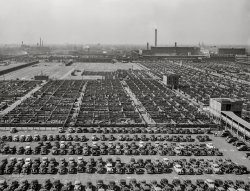
- Going Alone: 1907
- Chicago circa 1907. "Illinois Central Railway station." 8x10 inch dry plate ... in 1974. What were people thinking in the 1970s?!
Chicago I would have preferred Wrigley Field, but this is acceptable :-)
... to the Illinois Central, the Cleveland, Cinncinati, Chicago & St. Louis (CCC&StL), the Michigan Central, and the Wisconsin ... Posted by Dave - 11/04/2016 - 10:50am -
![Going Alone: 1907 Chicago circa 1907. "Illinois Central Railway station." 8x10 inch dry plate glass negative by Hans Behm for Detroit Publishing Co. View full size.
Grand PictureOne of the best yet. Surreal.
Weather vaneIs that lofty wind vane a train? How high up is it?
I'm always amazed that these high structures were built without modern cranes; scaffolding?
[They would have used 1907 cranes. Which were modern at the time. - Dave]
A classicReminds me of the Wyeth painting "Christina's World".
Why?I just cannot understand why such a grand building was demolished in 1974. What were people thinking in the 1970s?!
ChicagoI would have preferred Wrigley Field, but this is acceptable :-)
An opposing viewEarlier we saw the view from the other direction, looking north out from the station.
Pomp and mobilityI am always amazed about how much our modern airport architects still have to learn from the train station architects of yore.
So far I have only seen very few airports which have the quality, the feel, the celebration of mobility and travel, the sheer pride of those old train stations.
Number 2 Park Row HouseA 1901 photo with a similar view can by found here. At the left of this photo you can see how close Lake Michigan used to come to the station which was near the corner of present day Michigan and Roosevelt Avenues. The extract from the 1904 Talbot Railroad and Industry Map below shows the beginnings of how they filled in Lake Michigan to expand the park that was already along the lake shore. The large number "8" near the bottom of the map is where the station was located. The Google map view here, shows how the park looks today.
The station was operational from 1893 - 1972, but it was demolished in 1974. In addition to the Illinois Central, the Cleveland, Cinncinati, Chicago & St. Louis (CCC&StL), the Michigan Central, and the Wisconsin Central railroads all used the Illinois Central station in 1904, but many other railways had track rights over the course of the station's existance.
The Labey & Wirsing Saloon shown in the both photos, actually at 2 Lake Park Place despite the inscribed wording at the top of the building, was the establishment of Harry W. Labey and Harry Wirsing. Labey was an English immigrant born in 1871, and Wirsing was a German immigrant born in 1862. In 1900 they were both living in the upstairs rooms of the building. They ran this business from 1897 until at least 1907. Labey later ran a saloon at 108 LaSalle Street next to the old Chicago Stock Exchange.
(The Gallery, Chicago, DPC, Railroads)](https://www.shorpy.com/files/images/SHORPY-4a22390a.thumbnail.jpg)
- Smoke on the Water: 1905
- Chicago, 1905. "Chicago River east from Rush Street Bridge." Detroit Publishing Company glass ... see a bridge at Rush Street. I've only been to downtown Chicago a couple of times, but looking east down the Chicago River from Rush ... Posted by Dave - 08/20/2012 - 9:53am -
![Smoke on the Water: 1905 Chicago, 1905. "Chicago River east from Rush Street Bridge." Detroit Publishing Company glass negative, Library of Congress. View full size.
Sticky fingers?This must have been a popular plate. Quite a few fingerprints on this one.
[It's mostly a handprint. - Dave]
Tall ShipThe tall ship on the left is a bit of a surprise--wonder was it commercial as well?
And the two guys on the tug barge--I'd like to see closeups of them. They've got a great vantage point!
Is this bridge gone now?I looked at a map and I don't see a bridge at Rush Street. I've only been to downtown Chicago a couple of times, but looking east down the Chicago River from Rush Street would be looking towards Michigan Avenue one block to the east. But I don't see the Michigan Avenue Bridge. Can anyone help? I'm guessing the Rush Street Bridge was torn down after this photo was taken and the bridge at Michigan Avenue was built later.
[Google "Rush Street Bridge" and you'll have the answer in about 10 seconds. - Dave]
Spencer, Bartlett warehouseThis leading hardware dealership was the descendant of a Chicago store called Tuttle, Hibbard & Co., which took that name in 1855 when William G. Hibbard became a partner. In 1865, Hibbard was joined by Franklin F. Spencer, and the enterprise was renamed Hibbard & Spencer. By 1867, the company's annual sales of hardware had reached $1 million. When longtime company employee A. C. Bartlett became a partner in 1882, the company's name became Hibbard, Spencer, Bartlett & Co. When Spencer died in 1890, the company was already among the leading wholesalers of hardware in the United States. In 1903, the year Hibbard died, the company opened a 10-story warehouse next to State Street Bridge in downtown Chicago. In 1932, the company introduced a new line of hand tools under the brand name "True Value."
-- Encyclopedia of Chicago History
The SchoonerThe three masted schooner tied up by Kirk Factory #2 is very much a commercial vessel. She's showing her age too. These ship would have stayed in service for years after steamers became common. They'd stay in service pretty much until they wore out. Probably the most famous fishing schooner of them all, the Bluenose (the ship on the Canadian dime) was in commercial service in 1946when she went down off of Haiti.
Tug Harry C. LydonThe tug, Harry C. Lydon, was built in 1898 in Benton Harbor, MI. (Maritime History of the Great Lakes). She was employed by the Chicago and Great Lakes Dredge and Dock company which was a subsidiary of the Great Lakes Dredge and Dock Company, which still exists.
The tug's namesake, Harry C. Lydon, was vice-president of the Chicago & GT Lakes D & D Co. and brother of William A. Lydon, President and co-founder of the Great Lakes Dredge and Dock company. Harry died in November 1903 at age of 32.
The tug is towing a barge of what appears to be dredge spoil, perhaps related to the project referenced in the following article.
Detroit Free Press, Sep. 6, 1904
CHANNEL WORK PROGRESSING
Toledo, September 5. - Great progress has been made with the enlargement of the straight channel. Manager Murray, of the Chicago and Great Lakes Dredge and Dock company, which is doing the work, said yesterday after examining the work out in the bay, that the inner end of the channel will be finished by early in November. Thus there will be a channel 400 feet wide and twenty-one feet deep from the crib lights to the Wheeling bridge. Next summer the outer and shorter end of the channel from the crib range to the new harbor light will be completed.
Rio DetroitSon geniales, me encantan!!!
:))
(The Gallery, Boats & Bridges, Chicago, DPC)](https://www.shorpy.com/files/images/4a12889u.thumbnail.jpg)
- 3rd Int'l Pageant of Pulchritude
- ... Roommates.
BZZZT! and the correct answer is... Miss Chicago. hubba...
First Runner-Up Raymonde Allain, Miss France 1927, ... Police had it shut down for showing too much leg.
Miss Chicago took 1st in 1928 and Miss France took 2nd which obviously means ... ... Posted by Dave - 09/07/2011 - 5:40pm -
![3rd Int'l Pageant of Pulchritude Third International Pageant of Pulchritude and Ninth Annual Bathing Girl Revue, June 1928. Galveston, Texas. View full size.
Proto Emo GirlI think I'm in love with the clad-in-black Miss New Jersey.
Meanwhile Miss Nebraska is expressing the love whose name cannot be spoken for Miss Wisconsin.
Congratulations to Miss St.Congratulations to Miss St. Louis, 42nd runner-up.
Mrs?Shouldn't that be "Mr. France". Oofah!
HuhI like how we range from Miss Biloxi to Miss England. I'm surprised we didn't have Miss 22nd Street and Miss Asia, too.
By the way, I know standards of beauty have changed, and the women in pageants today are not necessarily more or less attractive, but Miss St. Louis was a beast. I'm sorry, there had to be some corruption in that contest.
Miss St. LouisBut look at her body. It's all about the body.
NiceMiss Mississippi is fine...
Hm.Objectifying women across the centuries!
Coincidence??Miss France and her predecessor. Different hats, but that nose ... eerie, huh?
Miss St. LouisWhat's the problem with her? Look at her smile...
Miss MilwaukeeAll the way ! A beauty any man could fall in love with.
Funny that......I was thinking the same about that bloke dressed up as Miss St Louis...
SeawallSo they stuck the out-of-town contestants on the beach for the group photo, while the oglers watch from the seawall?
Those Galvestonians learned something from that hurricane!
Fun, Best Legs, Shock JockMiss California gets my vote, she's looks like alot of fun! Miss Utah has the best legs, and Miss St. Louis is Howard Stern in a bathing suit.
PoPI swear Miss Greater New York is winking. Fabulous.
Roaring 20's!See the trends move fast near the end of the decade. Some areas chose slimmer gals that appear to better fit the Flapper styles of the times. Many men of the day would see Miss Austin as being horribly sickly, but today she would have the attributes of a runway model! And yes, Miss CA is absolutely adorable, and the St. Louis pageant must have had very few contestants.
Miss OhioI think Miss Ohio cornered the Amish vote. Miss Utah is one cute little Mormon pixie, working her flirt something fierce- that girl you could paste into a modern photo and nobody would think twice about it.
It's funny how wildly different they all look- a modern contest the girls would all look more or less the same. This photo is a crazy assortment of beauties & cuties, geek girls, dorks, farm girls, prom queens, and linebackers. Awesome!
Lots of Fine Choices in Girls Here ...Take a close look at Miss Pennsylvania. She's showing off some ummmmm talents. Not too shabby. And she is the only one with those. But it seems she and Miss Ohio are wanting to trip the light fantastic. So she's likely spoken for, unless a threesome would work. I have to agree, Miss California looks like a good candidate. Also check Miss Colorado, pretty cute looking although zero to concave up topside.
But clearly this whole contest is rigged, considering Miss St. Louis and Miss France. Holy cow! Either one would be worth chewing your arm off if you woke up next to them with it stuck underneath. They must have done multiple special couch sessions with a bag over their head and paid a bunch of cash just to get into this line up. What on Miss Spain's forehead? Is that the reset button?
1st Prize to Miss BiloxiShe's quite alluring, but does need to work on her posture.
Honorable mentions to Miss San Antonio (very cute), Miss Belgium (best smile), and Miss NY State (quite sexy even by 2009 standards).
And I agree, Nebraska's totally putting the moves on Wisconsin. But so would I. Pennsylvania and Ohio must be roommates. Yeah, that's it. Roommates.
BZZZT! and the correct answer is...Miss Chicago. hubba...
First Runner-UpRaymonde Allain, Miss France 1927, became an actress -- the Internet Movie Database lists her as appearing in 10 films and (in 1974) a television show. She also wrote a book in 1933, "Histoire vraie d'un prix de beaute?" ("True story of a price for beauty"). She married the pianist and composer Alec Siniavine, who composed a love song for her during the Nazi occupation, "Attends moi mon amour." Siniavine also played in a quartet with Django Reinhardt in 1934.
[Miss Allain to the New York Times in 1928: "It is certainly great to be beautiful." - Dave]
"Galveston Bathing Beauties"The event lasted from 1920 to 1931, when the Morality Police had it shut down for showing too much leg.
Miss Chicago took 1st in 1928 and Miss France took 2nd which obviously means ... Miss Missouri was ROBBED!!! Come on, Miss Missouri had the whole package yet she didn't even finish in the top 10?!!
Results
1 UNITED STATES - Ella Van Hueson (Miss Chicago)
2 FRANCE - Raymonde Allain
3 ITALY - Livia Marracci
4 COLORADO - Mildred Ellene Golden
5 WEST VIRGINIA - Audrey Reilley
6 CANADA - Irene Hill
7 LUXEMBOURG - Anna Friedrich
8 OHIO - Mary Horlocker
9 SAN ANTONIO (TX) - Anna Debrow
10 TULSA (OK) - Helen Paris
Contestants
Foreign
BELGIUM - Anne Koyaert
CANADA - Irene Hill
CUBA - Nila Garrido
ENGLAND - Nonni Shields
FRANCE - Raymonde Allain
GERMANY - Hella Hoffman
ITALY - Livia Marracci
LUXEMBOURG - Anna Friedrich
MEXICO - Maria Teresa de Landa
SPAIN - Agueda Adorna
USA states or regions
CALIFORNIA - Geraldine Grimsley
COLORADO - Mildred Golden
CONNECTICUT - Mary Deano
INDIANA - Betty Dumpres
IOWA - Ethel Mae Frette
KENTUCKY - Vergie H. Hendricks
LOUISIANA - Evelyn Smith
MINNESOTA - Delores Davitt
MISSISSIPPI - Louise Fayard
MISSOURI - Margaret Woods
NEBRASKA - Bernice Graf
NEW JERSEY - Elizabeth K. Smith
NEW YORK STATE - Winnifred Watson
OHIO - Mary Horlocker
PENNSYLVANIA - Anna Dubin
UTAH - Eldora Pence
WEST VIRGINIA - Audrey Reilley
WISCONSIN - Betty Porter
USA cities
AUSTIN (TX) - Irene Wilson
BILOXI (MS) - Fleeta Doyle
CHICAGO (IL) - Ella Van Hueson
DALLAS (TX) - Hazel Peck
FORT WORTH (TX) - Cleo Belle Marshall
GREATER NEW YORK (NY) - Isabel Waldner
HOUSTON (TX) - Katherine Miller
LITTLE ROCK (AR) - Frances McCroskey
MILWAUKEE (WI)
NEW ORLEANS (LA) - Georgia Payne
OKLAHOMA CITY (OK) - Mary Kate Drew
SAN ANTONIO (TX) - Anna Debrow
ST. LOUIS (MO) - Eunice Gerling
TULSA (OK) - Helen Paris
http://www.pageantopolis.com/international/universe_1920.htm
Now you've got some names to go with the faces.
[What was at stake was no less than the title of Miss Universe. Controversy erupted when Miss France, Raymonde Allain, came in second to an American girl. - Dave]
Pageant of Pulchritude 2009Seems like the pageant once again is on, after 77 years absence. Found this
http://www.houstonpress.com/slideshow/view/13011295
Butter faceis what we would call Miss St. Louis nowadays. Miss Puffsylvania gets my trophy!
(The Gallery, Pretty Girls, Swimming)](https://www.shorpy.com/files/images/6a24745u_2.thumbnail.jpg)
- Chicago & Alton: 1904
- Circa 1904. "Chicago & Alton Railroad shops at Bloomington, Illinois." At left rear, the ... Posted by Dave - 01/10/2014 - 11:45am -
![Chicago & Alton: 1904 Circa 1904. "Chicago & Alton Railroad shops at Bloomington, Illinois." At left rear, the Anheuser-Busch beer boxcar. 8x10 inch glass negative. View full size.
GraffitiI like the graffiti on the side of the train. People were doing that even back then. Interesting.
[The chalk markings are from the yard crews, noting such things as routing, special content advisories, repairs required, etc. Often seen on rail yard photos here on Shorpy. -tterrace]
C&A Blues"I said, let me tell you, peoples
What the C&A will do for you
Well, now she will take yo' little woman
Then will holler back at you..."
From The C&A Blues, by Peetie Wheatland, circa 1930
No DumpingThe old shops are gone, you can still see the foundations on Google Earth at
https://goo.gl/maps/BQFNq
It looks like there may have been a turntable just to the south of the main building.
Also, the shops can be seen in an old postcard on the Wikipedia page for the Alton Railroad at
http://en.wikipedia.org/wiki/Alton_Railroad
There is no good street view of the site, the road stubs leading into the site all have the same sign: No Dumping.
(The Gallery, DPC, Railroads)](https://www.shorpy.com/files/images/SHORPY_4a20233a.thumbnail.jpg)
- Union Stockyards: 1941
- July 1941. "Union Stockyards. Chicago, Illinois." Medium format acetate negative by John Vachon for the Farm ... of Vachon's image is the Exchange station platform of the Chicago Elevated rail transit line that served the Stockyards. You can see a ... probably not if you're a cow.
"How sad, to leave Chicago. I have had such a wonderful week." John Vachon's letters to ... Posted by Dave - 02/06/2020 - 12:23pm -
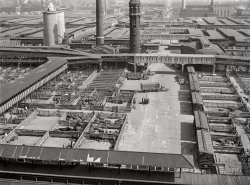
- Lincoln Park: 1905
- Chicago circa 1905. "Children's bathing beach, Lincoln Park." 8x10 inch dry ... chubby kid in sight.
Some things never change in Chicago Great shot. Can't help but notice the cop controlling the crowd ... of the water.
A very strange photo.
(The Gallery, Chicago, DPC, Kids, Swimming) ... Posted by Dave - 09/13/2011 - 7:01pm -
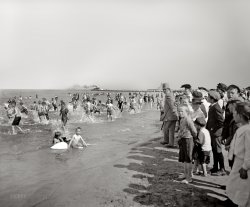
- Black and White: 1942
- ... 1942. "General view of a classification yard at the Chicago & North Western RR's Proviso Yard." View full size. 4x5 ... hits for Southern Central Railroad . - Dave]
Chicago and NW'ern Pic Getting back to the photo, this is simply ... even came in 4x5.
(The Gallery, Kodachromes, Chicago, Jack Delano, Railroads) ... Posted by Dave - 07/20/2012 - 3:45pm -
![Black and White: 1942 December 1942. "General view of a classification yard at the Chicago & North Western RR's Proviso Yard." View full size. 4x5 Kodachrome transparency by Jack Delano for the Office of War Information.
Long Train RunningI always want to look for a Southern Central Freight in pictures like this.
Southern Central?Don't understand this. You are looking for a freight car with Southern Central markings? Haven't heard of this line. Do you mean Southern Pacific or plain Southern?
[Down around the corner, a half a mile from here, you see them old trains running, and you watch them disappear. Doobies. - Dave]
He HeOh man . . . the posts here are priceless.
Southern Central??Unless this line was a little unknown short line, in the southern states, I've never seen any recordings of it. It could of also been merged into the Southern or Southern Pacific RR's during the time of RR expansion in the late 1800's or early 1900's. Do you know where this RR was located?
[Maybe you've heard a recording of it. That was a humorous reference to a song lyric -- "Long Train Running" by the Doobie Brothers ("Well the Illinois Central, and the Southern Central freight, gotta keep on pushing mama, cause you know they're running late"). Plus there are 1,600 Google hits for Southern Central Railroad. - Dave]
Chicago and NW'ern PicGetting back to the photo, this is simply breathtaking in its clarity and detail. Never knew beloved Kodachrome even came in 4x5.
(The Gallery, Kodachromes, Chicago, Jack Delano, Railroads)](https://www.shorpy.com/files/images/1a34647u1_0.thumbnail.jpg)
- Department store Christmas in Chicago
- Diane C. Majka, Approximately 1950, Christmas, Chicago. Scan from 4x6 print on textured paper. View full size.
Ummmm ... Posted by Eudaemonius - 09/20/2011 - 12:40pm -
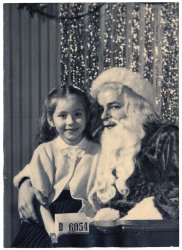
- My Grandfather in Chicago: 1893
- ... at Smith & McWhinney studios at 418 63rd Street in Chicago in 1893. If anyone else has photographs from this studio please let me ... Posted by GuyChallis - 04/28/2019 - 10:10am -
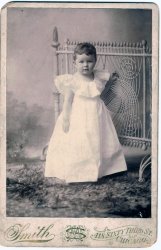
- Chicago Sweatshop, c. 1912
- ... right) worked as a seamstress her entire life in various Chicago sweatshops. She was born in 1896, two months after her father died, and ... Posted by Tinsel - 09/20/2011 - 9:09pm -
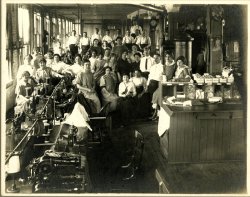
- Chicago Christmas: 1956
- ... Christmas. He was about 8 here. Kodachrome slide taken in Chicago in 1956. View full size.
Your photo and story in a magazine ... Posted by polishprinsezz - 09/16/2011 - 1:52pm -
![Chicago Christmas: 1956 My father playing with his cousin and the Lionel train set he got for Christmas. He was about 8 here. Kodachrome slide taken in Chicago in 1956. View full size.
Your photo and story in a magazineHi, I am senior editor at Classic Toy Trains. We would be interested in publishing this vintage color photo and learning more about the background .
Please contact me at:
Roger Carp
262-796-8776 ext. 253
rcarp@classictoytrains.com
Thanks,
Roger
[To contact the photo's owner, click their username (above the photo after "Submitted by"), then the Contact tab on their Profile page. -tterrace]
(ShorpyBlog, Member Gallery, Christmas)](https://www.shorpy.com/files/images/4-16-2011_12-21-38_032.thumbnail.jpg)
- Window-Dressing: 1941
- July 1941. "Store window display. Chicago, Illinois." High concept retailing -- one's eye is drawn immediately to the fancy footwear on display. Or maybe summers in Chicago are just especially hot? We'll leave the interpretation up to you. 35mm ... Posted by Dave - 02/18/2013 - 1:45pm -
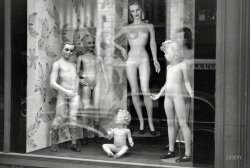
- North State St., Chicago: 1949
- ... of a busy city street. The El in the far distance, the Chicago Theatre marquee in the near distance. The Butler building is now known ... Siskel Film Center, and is a part of the Art Institute of Chicago. A school that coincidentally, my mother was studying at in 1949. ... Posted by Deborah - 02/28/2014 - 8:31pm -
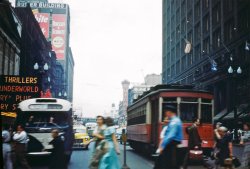
- Goliath & Goliath: 1942
- December 1942. "Locomotives in the Chicago and North Western departure yard about to leave for Clinton, Iowa." ... switching duties, as noted by Steamin.
(The Gallery, Chicago, Jack Delano, Railroads) ... Posted by Dave - 07/12/2023 - 2:39pm -
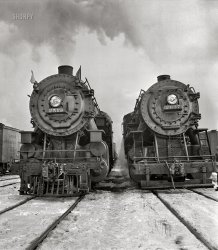
- Yerkes Mansion: 1908
- ... Bain Collection. View full size.
Creator of the Chicago Loop Charles Tyson Yerkes, as the robber-baron-in-chief of Chicago traction, acquired a distinctly unsavory reputation in the Windy City ... Posted by Dave - 06/06/2011 - 3:25am -
![Yerkes Mansion: 1908 New York circa 1908. "Charles T. Yerkes house, Fifth Avenue and East 68th." 8x10 glass negative, George Grantham Bain Collection. View full size.
Creator of the Chicago Loop Charles Tyson Yerkes, as the robber-baron-in-chief of Chicago traction, acquired a distinctly unsavory reputation in the Windy City and was eventually run out of town. But he created - by hook AND by by crook - one of Chicago's greatest assets: the elevated railroad loop that encircles the downtown business district, which was completed in 1897. The name "Loop" derives from the turn-around circuits of the cable car lines built in Chicago in the 1880s, but it is forever linked to the giant elevated train merry-go-round that remains a favorite with residents, tourists, and filmmakers alike.
"City Loses Yerkes Library"Financier and public transportation developer Charles T. Yerkes was one of those 19th Century capitalists whose ruthless business practices defined the term "robber baron." When he died of kidney disease in 1905, he was residing in an apartment at the Waldorf Astoria Hotel, and not in the mansion seen here, which was occupied by his wife, as reported in his New York Times obituary on December 30, 1905.
The Yerkes mansion was in the news again in 1908, when the Times reported that its attached library and art gallery, willed by Yerkes to the city for public use, was instead being lost to foreclosure.
Couldn't be more... spooky!
East 68thSomewhere along the street is an apartment building owned by a couple named Mertz.
On The AvenueIn 1895 the Yerkes Mansion was replaced by Thomas Fortune Ryan, another robber baron, who built an even larger house and garden on 2 lots. That lasted until 1950 when the architecturally ordinary 860 Fifth Avenue was built for the rich and famous.
Gone and ForgottenWhen I first saw this picture I thought "Who in the world was Charles T. Yerkes and what is he famous for?"
Well, after reading the remarks, I have decided that it is to mankind's benefit that the man has been, more or less, forgotten in just over 100 years. Too bad he didn't use some of his ill gotten gains to help people. Maybe his name would be remembered in the same spirit as Andrew Carnegie.
[He did get those rail lines built, and provided employment for thousands. As for the pejorative term "robber baron," the people who most objected to those sharp elbows were other industrialists. - Dave]
Yerkes ObservatoryI'm familiar with Yerkes in association with the observatory by that name. The U. of Chicago astronomer George Ellery Hale persuaded him to fund the observatory by pointing out that his name would be on the largest telescope in the world. Those tycoons love having their egos stroked, eh.
Dreiser booksTheodore Dreiser wrote three books "suggested" by Yerkes' life ("The Financier," "The Titan" and "The Stoic"), and they are a great read for anyone interested in that time period.
(The Gallery, G.G. Bain, NYC)](https://www.shorpy.com/files/images/01397u.thumbnail.jpg)
- Chicago's Little Italy: 1931
- ... camera facing east toward Loomis Street in Little Italy, Chicago, 1931. View full size.
(ShorpyBlog, Member Gallery) ... Posted by gwolande - 01/13/2011 - 9:52am -
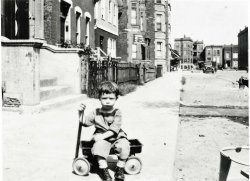
- Hager and Related Families, Chicago, circa 1910
- ... Wilhelm Hager and his extended family, circa 1910 in Chicago.
Back Row, L-R: John Meseth; his wife, Louise Seafeldt; Liz's half ... Posted by hager2007 - 06/11/2007 - 2:41am -
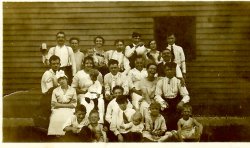
- Negro Cabaret: 1941
- April 1941. "Negro cabaret, South Side Chicago." The Boyd Atkins Band. Acetate negative by Russell Lee for the Farm ... the Society Swingsters in Peoria.
[This is a Chicago nightclub. Doesn't anyone read the captions? - Dave]
Various ... Claudie Oliver is the front dancer. Interesting that the Chicago Tribune had exactly zero references to band-leader Boyd Atkins from ... Posted by Dave - 09/05/2012 - 7:07pm -
![Negro Cabaret: 1941 April 1941. "Negro cabaret, South Side Chicago." The Boyd Atkins Band. Acetate negative by Russell Lee for the Farm Security Administration. View full size.
Swept awayHey, we're trying to make a classy photo up here. Someone get that broom and the thingamabob outta that little room there. What's folks gonna think in 2009?
Boyd AtkinsSaxophonist and bandleader. Wrote "Heebie Jeebies," which as recorded by Louis Armstrong was one of the first hit songs to feature scat singing.
Probably PeoriaIf it's 1941, it's more than likely this is Boyd Atkins fronting the Society Swingsters in Peoria.
[This is a Chicago nightclub. Doesn't anyone read the captions? - Dave]
Various PatronsInteresting that most of the customers are white. The zoot-suited hepcat on the balcony looks like one of Will Smith's ancestors.
Swanky JointMakes me want to go out and buy a suit and tie. And start smoking.
Black and whiteJust about any nightclub on the South Side would have been considered "Negro" at the time -- the owner was probably black, it was in a famous black neighborhood, and most if not all of the name talent was black. Which isn't to say you wouldn't find lots of white folks there -- "slumming" had been considered fashionably adventurous well before the advent of swank watering holes like this.
Anyone got a time machine?I need to go back and meet the dancer in front on the right.
Cotton gin millHow very Cotton Club it all seems (except for the Caucasian people in the audience). The expressions on the faces of the dancers are very... distant. Many of these old timey dance pictures show girls with bright, lipsticked smiles. These expressions seem to range from concentration to disdain.
Dave's Cafe I think I found the place. This is absolutely the right area, the right era and the right aura. Lena Horne is leaning on a railing that matches the Shorpy photo and it looks like "show stopper" Claudie Oliver is the front dancer. Interesting that the Chicago Tribune had exactly zero references to band-leader Boyd Atkins from 1930 to 1960. The great South Side black paper, The Chicago Defender, had dozens.
The Chicago Defender, September 14, 1940 - Joe Johnson's Production Is Hot Harlem Done Up in 'Chi' Bronze
What Little Ziggy Johnson has done for Dave's Cafe a-la floor show is more than patrons expected, even more from Ziggy. Johnson has some names; lots of dance, fine singing and a beauty line you find worthy of a rave. But even better yet, my friends, Little Ziggie has surrounded himself with such well-known artists as: Ted Smith, a radio star with the silver toned voice; Maxine Johnson, sweet singing Canadian songbird; Leroy "Pork Chop" Patterson, three hundred pounds of mirth and melody; Spizzie and George, a pair of clever dancers that have everything that the public wants and then those nationally-known society dancers, Johnson and Grider, a mixed team of terpsichoreans that display art with every move.
Margie Smith, Bea Rhinehart, Arrabelle Martin, Ollie Dell Southern, Harriett "Hickey" Hickerson, Cecelia Jones, Mammie Morton and Claudie Oliver are the eight shapely line girls. one of the girls, Claudie Oliver, shows exceptional cleverness as she tags the finale "Tuxedo Junction." Boyd Atkins and his music master add the final touch to a show well worth seeing.
Salad of the Bad CafeI got food poisoning once from the shrimp salad at a place just like this!
Black and TanHow very Cotton Club it all seems (except for the Caucasian people in the audience).
Blacks were usually barred from the Cotton Club, except as performers.
Looking through the Defender archives, I ran into the term "black and tans" a lot, for black and white bars. Without black customers, I don't know if the Cotton club qualified. A mixed audience may have been progressive at the time, but notice who gets all the front seats, and who's restricted to the back rows and the balcony.
Cotton Club audienceIt was said: How very Cotton Club it all seems (except for the Caucasian people in the audience).
The audience at the Cotton Club was Caucasian.
Club GlumThere is not one person smiling as the photographer clicks the shutter. Not one. Not even the dancers.
This photo could hardly be used as an advertisement for having a fun night out!
South SiderThis photo predates me by a couple of years. I was raised on the South Side of Chicago and would love to know where this photo was taken.
Clarification*SIGH!* I meant "except for the African Americans in the audience." Thanks to those who corrected me. I was surprised to see brown skin even at back tables and in the upstairs. As someone who wouldn't want to sit at a strip club, either, I find it VERY weird how many women are with the men watching the dancers. Wouldn't that feel just awkward, especially back then!? Apparently not.
[This is your standard mid-century nightclub floor show. Pretty much gone with the wind except maybe in Vegas. - Dave]
Lollipops?It seems, that there are lollipops on some tables. Were they popular at that time?
[More like little xylophone mallets. To tap out your applause or perhaps to stir your cocktail. - Dave]
"Lollipops"Those are noisemakers called knockers. There would be one for every patron at the table. They were struck against the table (if unclothed) or mostly on the glassware. It was used as an applause mechanism by the celebrants. At New Year's Eve events they were, like the funny hats, expected accoutrements. Usually embossed with the venue's name & address, they were taken home as souvenirs of a night out.
The beer that gave Milwaukee the Schlitz!Thanks for the close-up on the knockers because I see a bottle of Schlitz beer. You know, it was brewed with just a kiss of the hops, not the harsh bitterness. Just saying.
Boyd AtkinsAtkins (standing with sax) seems a rather obscure figure considering his illustrious associations -- playing in Fate Marable's legendary band steaming up and down the Mississippi at the end of the 1910s, then with Louis Armstrong in the 1920s, etc. in addition to leading his own bands. Trombonist Kid Ory, in a 1957 interview, recalled playing in Boyd Atkins band in Chicago in the 1920s when two rival gangs of Chicago gangsters opened fire on each other. I wonder if the venue was similar to this one.
SwinglandThis was at 343 E. 55th Street near Washington Park. Other names for the club were Swingland Cafe (1938 at least) and Rhumboogie (April 1942 to 1947). Building looks to be long gone.
(The Gallery, Chicago, Music, Pretty Girls, Russell Lee)](https://www.shorpy.com/files/images/8c00639u.thumbnail.jpg)
- Chicago, Burlington & Quincy 4000
- Built in 1930 and looking like any other locomotive, CB&Q #4000 was dressed with a shroud in 1937 and named "Aeolus" (keeper of the wind). I would imagine that during the Depression it was one way to make travel more inviting. The shroud was r ... Posted by Atomic Rocket - 09/20/2011 - 10:22pm -
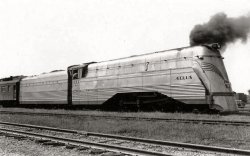
- Wabash Avenue L: 1900
- ... September 1, 1900. "Wabash Avenue north from Adams Street, Chicago." 8x10 inch dry plate glass negative, Detroit Publishing Company. ... companies sign and found the Charles M. Gall Company in Chicago at that time. They were also mentioned in the "Monument Mans Handbook" ... Posted by Dave - 07/20/2012 - 3:44pm -
![Wabash Avenue L: 1900 September 1, 1900. "Wabash Avenue north from Adams Street, Chicago." 8x10 inch dry plate glass negative, Detroit Publishing Company. View full size.
Direct connectionThe walkway from the building to the station used to be common; many stops in the Loop on the L and in the subway had a direct connection from some adjacent business; it was a selling point for the business.
The ones on the L are all gone now. Most of the subway ones are closed as well, with the exception of the ones that are part of the pedway.
GottchaWonderful street scene. Can you find the "Gottcha"? Or what on first glance appears to be a "Gottcha."
Signage That is an interesting sign behind the Pilgrim Press Booksellers. The one that has pictures of monuments or crosses on it. It would be nice to have a closer look at that.
I did a little more research just guessing it is a monument companies sign and found the Charles M. Gall Company in Chicago at that time. They were also mentioned in the "Monument Mans Handbook" from 1919. The book had illustrations of types of monuments and it seems that some on the sign are military monuments. Of course, I could be totally off base and if anyone has any other ideas let me know.
A Story In Every SignBarely visible below and to the right of the Windsor Clifton sign is a sign for Alfred Peats. According to his March 1915 obituary in the NYT, Peats made money so fast he was "crazed by riches" and driven insane. He ended up at the Bloomingdale Asylum.
For that total Shorpy experienceI like to play my Scott Joplin CD while looking at these turn of the century street scenes in Hi-Def. It's almost like watching a Ken Burns documentary.
It seems odd that his music was used in a soundtrack for a movie set in the 1930s (The Sting) when most of his work was written around 1900. I would have thought hot jazz a better choice for that movie, given the period.
The GottchaIs that someone misspelled "gotcha"?
How Often ...Jake: How often does the train go by?
Elwood: So often that you won't even notice it.
Are these what are known as "cold water" flats due to the water pipe running vertically from the sidewalk? There seems to be one valve or "tap" for each flat accessible from the veranda. What happened in the winter when the water froze?
Got HER!The man walking by the bookshop at lower left appears to be goosing his female companion.
GotchaAre you referring to the woman who appears to be scratching her behind? At first glance it looks like the man walking slightly behind her is "taking liberties," but after closer examination I believe he is innocent.
[I think she's lifting her skirt a bit to keep it off the sidewalk. Hey lady, you're on the Internet! - Dave]
Her Own ParadeAnd believe me, I'd be in it too!
PlumbingThose look like standpipes for firefighters. You can see the terminus of one on the top of the building on the right side of the street. Rather than drag a hose all the way up from the street hydrant they could hook on to the standpipe and direct water to whatever floor needed it, or all the way to the roof.
Chicago in the mid 1970sAs a HS student and camera buff, I used to go to the photo stores on Wabash Avenue, under the elevated tracks. Altman's Camera was one of the best places to buy equipment, and I would ride the train from Milwaukee with a pile of cash, arrive at the train station and then walk, nervously, east through pimps, hookers and street thugs to Wabash. Then I would walk back to the train station with my purchases, just as nervously. Boy, has Chicago cleaned up its act since those days.
Re: SignageMy guess is that it from the florist shop and shows designs for wreaths, possibly funerary.
CivilizedI notice not a hint of graffiti on the support beams for the elevated railway.
Fire ProtectionI'd guess those tall pipes are dry standpipes for firefighting. They'd be empty of water until hooked up to a pumper during a fire.
(And I think the hand on the lady's bottom is her own. The man appears to be carrying a parcel.)
Direct Connection, Part 2The bridge connecting the L Station (Madison & Wabash) to the buildings on the left side of the street was designed by Louis Sullivan for the Schlesinger & Mayer department store in 1896, when the Wabash Avenue leg of the Loop L was brand new. This was Sullivan's first work for the department store; he later built an entirely new building for them around the corner at State & Madison Streets (1899-1904). This building is better known by the name Carson Pirie Scott & Co., which occupied the structure from 1904 to 2007. While Sullivan's bridge is long gone, the building that it "plugged into" has recently had its facade restored, and some "lost" Sullivan ornament was recovered in the process.
Palmer HouseThe building on the left reads "Potter Palmer" near the top, which makes me think this might be the back of the second incarnation (1875-1923) of the Palmer House hotel. The front faced State Street, a block to the west.
Wabash Avenue L: 2010Some of the buildings on the right in the 1900 photo, just past the train, still exist. The very tall building in the center is the Trump Hotel and Tower across the river.
And yes, Pete is correct, that's the Palmer house on the immediate left. Between 1923 and 1925, the 2nd Palmer House was torn down while the 3rd (and current) hotel was built. So the hotel never closed during construction!
(The Gallery, Chicago, DPC, Railroads, Stores & Markets)](https://www.shorpy.com/files/images/4a08136a.thumbnail.jpg)
- Ed and Lou in Chicago: c. 1950s
- My parents on a date at a downtown nightclub in the early 1950s. Now in their 80s, and married for 57 years, they both love this photo, and so do I. He was a Navy vet from a coal-mining town in Pennsylvania. She was born and raised in the city, an ... Posted by msbosh - 03/24/2011 - 7:48am -
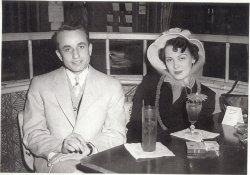
- Chicago: 1946
- Circa 1946, Chicago at 63rd and S. Halsted streets. This was the largest shopping area ... Posted by Norm Lasko - 09/24/2019 - 11:42am -
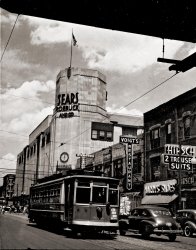
- Chicago, our first house: 1962
- This is our first house my folks bought in Chicago IL on 6050 South Wood street. My dad was in the service at the time, a ... Posted by ironacres - 01/15/2012 - 3:33pm -
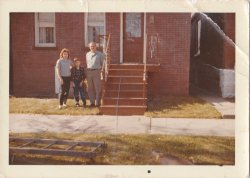
- Jerry Lewis in Chicago: 194x
- ... performed often at the Chez Paree night club in downtown Chicago. He and my dad Mel soon became good friends. One day in 1946 Jerry ... Posted by Shutan.com - 03/09/2018 - 7:32pm -
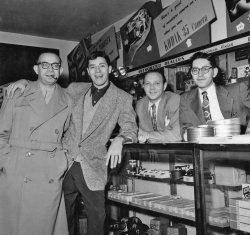
- Chicago back yard 1962
- ... Here is a back view of our first house my Dad bought in Chicago IL around 1962. I believe it was built around 1892 or so. But could be ... Posted by ironacres - 01/15/2012 - 3:31pm -
